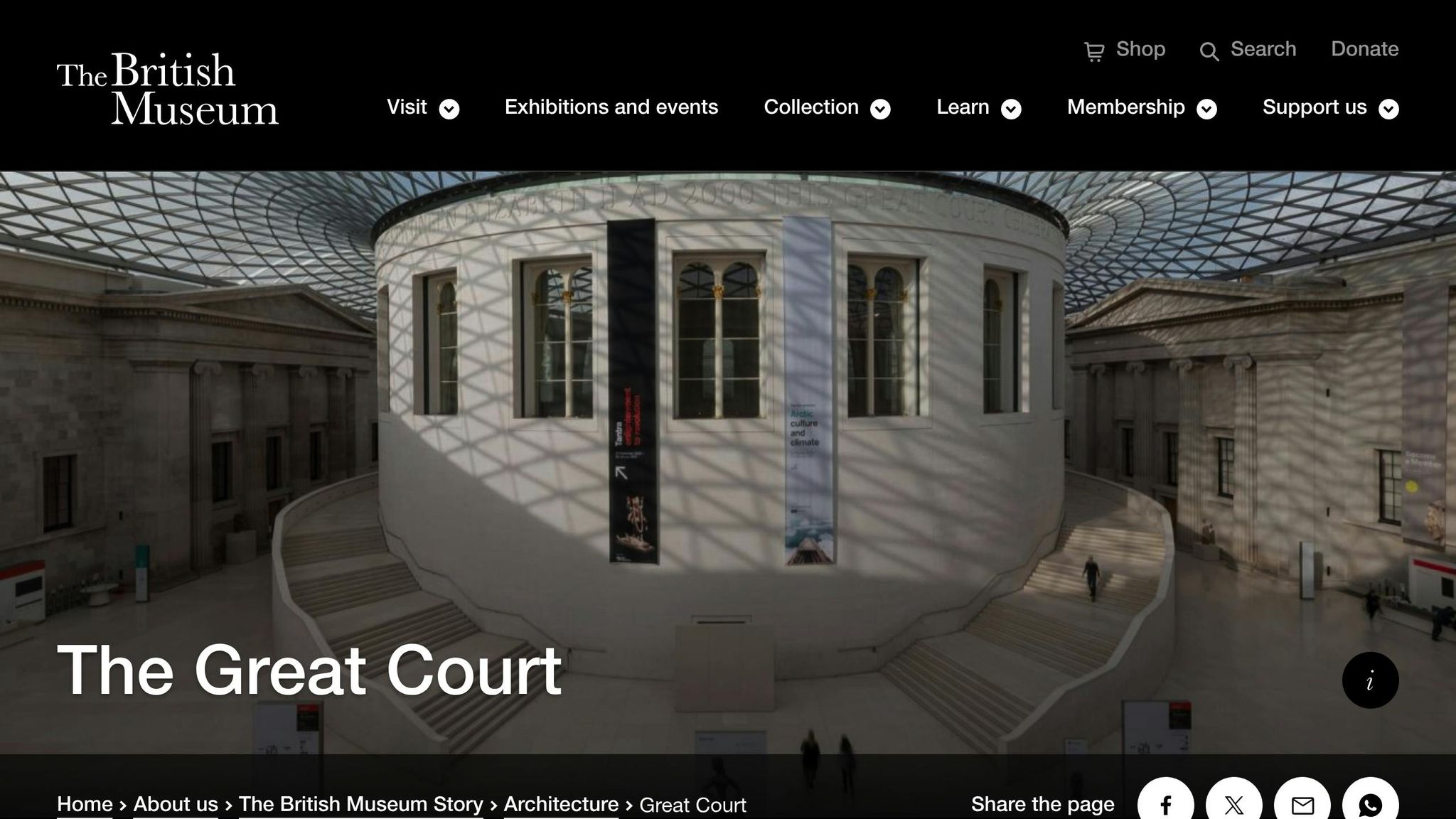Heritage sites are at risk of damage from vibrations caused by construction, traffic, natural factors, and even footfall. These vibrations can lead to micro-cracks, weakened foundations, and damage to artefacts, jeopardising the structural stability and historical value of these sites. Here’s what you need to know:
- Common Vibration Sources: Construction activity (high risk), vehicle traffic (moderate to high risk), pedestrian movement (low to moderate risk), and natural factors like wind and seismic activity (variable risk).
- Measuring Vibrations: Methods include ambient vibration testing, forced vibration testing, and impact testing. Tools like accelerometers and velocity transducers monitor vibrations in real-time.
- Setting Safety Limits: Standards like DIN 4150 and BS 7385-2 provide general guidelines, but limits should be customised based on material sensitivity, structural condition, and environmental factors.
- Reducing Impact: Strategies include modifying construction methods, traffic management, and creating buffer zones to protect heritage structures.
For effective preservation, regular monitoring and expert input are essential. Continuous testing can identify risks early, ensuring heritage sites remain intact for future generations.
Vibration measurements on a timber floor from a heritage …
Measuring Vibration Effects
Accurate measurement is the foundation of effective vibration control, playing a key role in preserving heritage structures.
Basic Testing Methods
Measuring vibration in heritage buildings involves a mix of specialised testing techniques:
- Ambient Vibration Testing: Captures the building’s natural movements under normal conditions.
- Forced Vibration Testing: Introduces controlled vibrations to observe how the structure responds.
- Impact Testing: Evaluates the building’s reaction to sudden forces.
These methods provide a detailed dynamic profile of the structure, helping to guide monitoring strategies and set safety limits. Sound of Silence uses these techniques with calibrated tools to create precise vibration profiles for heritage sites.
Monitoring Equipment
After testing, continuous monitoring helps protect structures over time. Modern systems rely on advanced sensors to provide real-time data. Common tools include:
| Equipment Type | Function | Application |
|---|---|---|
| Accelerometers | Measure acceleration and frequency | Monitor foundations and walls |
| Velocity Transducers | Track movement speed | Assess structural displacement |
| Data Loggers | Record continuous measurements | Long-term monitoring |
| Spectrum Analysers | Analyse frequency data | Study vibration patterns |
Building Tolerance Limits
Accurate measurements are essential for setting safe vibration limits. These limits depend on several factors:
-
Material Sensitivity
Heritage materials like masonry often have specific thresholds for vibration levels. -
Structural Condition
Factors such as age, past restoration work, existing weaknesses, and foundation stability must be considered. -
Environmental Factors
Elements like soil composition, groundwater levels, nearby vibration sources, and seasonal temperature shifts can all affect tolerance levels.
Acoustic consultants use these criteria to establish tailored vibration limits for heritage structures. Sound of Silence integrates structural evaluations with numerical analysis to determine safe thresholds for operation.
Regular monitoring and periodic testing ensure that control measures remain effective, keeping vibration levels within safe boundaries to protect these structures for the future.
Setting Safety Limits
Protecting heritage sites from vibration damage means combining established guidelines with tailored assessments for each location.
Standard Guidelines
Standards like DIN 4150 and BS 7385-2 offer baseline vibration limits. However, these general rules need to be adjusted to suit the unique characteristics of each heritage site.
Site-Specific Limits
Customising limits involves careful analysis of several factors:
-
Material Vulnerability
Traditional materials like lime mortars, timber, and stone react differently to vibrations. Limits must reflect the specific properties of these materials. -
Structural Age
Older buildings often have natural wear, previous repairs, or modifications. These factors mean stricter limits are often necessary to avoid further damage. -
Local Conditions
Soil type, groundwater levels, and seasonal changes can all influence how vibrations affect a site. Regular monitoring helps fine-tune the limits to account for these variables.
sbb-itb-06ab728
Reducing Vibration Impact
Minimising the impact of vibrations involves refining construction practices and managing external sources effectively.
Construction Methods
Working with acoustical experts is crucial for identifying construction techniques that limit vibration spread. Specialists can recommend specific approaches tailored to the needs of heritage structures. For example, Sound of Silence provides vibration testing and numerical analysis to design methods suited for protecting historic sites. Alongside construction adjustments, managing external vibration sources is just as important.
External Controls
Addressing external sources of vibration adds another layer of protection for heritage sites:
| Control Measure | Implementation Method | Expected Result |
|---|---|---|
| Traffic Management | Enforcing speed limits and restricting vehicle weights | Lower vibration levels from traffic |
| Buffer Zones | Creating safe distances from heavy machinery | Reduced exposure to vibration |
These measures should be implemented in collaboration with local authorities, with regular monitoring to ensure they remain effective. By combining targeted construction strategies with well-planned external controls, heritage structures can be better protected from vibration-related risks.
Example Projects
Here are some real-world cases showing how vibration control strategies are applied to protect historic structures in the UK.
British Museum Great Court

The renovation of the Great Court at the British Museum highlights how vibration control can be seamlessly incorporated into refurbishment projects within historic environments. While specific details about the measures used are confidential, the project demonstrates the importance of careful planning in such settings.
Historic Timber Buildings
Sound of Silence provides customised solutions to handle the unique vibrational challenges of timber structures. These approaches help maintain the integrity of historic wooden buildings during essential repair and upkeep.
Historic Bridge Protection
Preserving heritage bridges involves a mix of techniques, including load distribution, vibration dampening for older materials, and traffic management to reduce strain. These efforts illustrate the importance of tailored strategies in protecting historic bridges from damage caused by vibrations.
Summary
Main Guidelines
Protecting heritage sites from vibrations requires a systematic and preventive approach rooted in established conservation practices. Each site needs customised solutions, with regular structural evaluations and accurate monitoring forming the backbone of effective preservation.
Regular Monitoring
Keeping an eye on structural conditions helps identify problems early. A good monitoring plan should include:
| Monitoring Aspect | Frequency | Focus Areas |
|---|---|---|
| Structural Assessment | Quarterly | Foundation stability, wall integrity, joint conditions |
| Vibration Testing | Monthly | Traffic impact, construction activities, environmental factors |
| Data Analysis | Ongoing | Trend identification, threshold violations, seasonal variations |
Implementing these measures effectively often requires professional expertise.
Professional Support
To complement testing and monitoring, expert input is essential for managing vibration risks. Sound of Silence provides specialised solutions for heritage buildings, combining precise vibration testing, numerical analysis, and customised protection strategies. As they put it:
"Tailored and cost-effective solutions to meet your acoustic needs."
Their services cover both preventive actions and continuous monitoring, ensuring heritage sites are preserved for the long term with expert advice and advanced testing.

